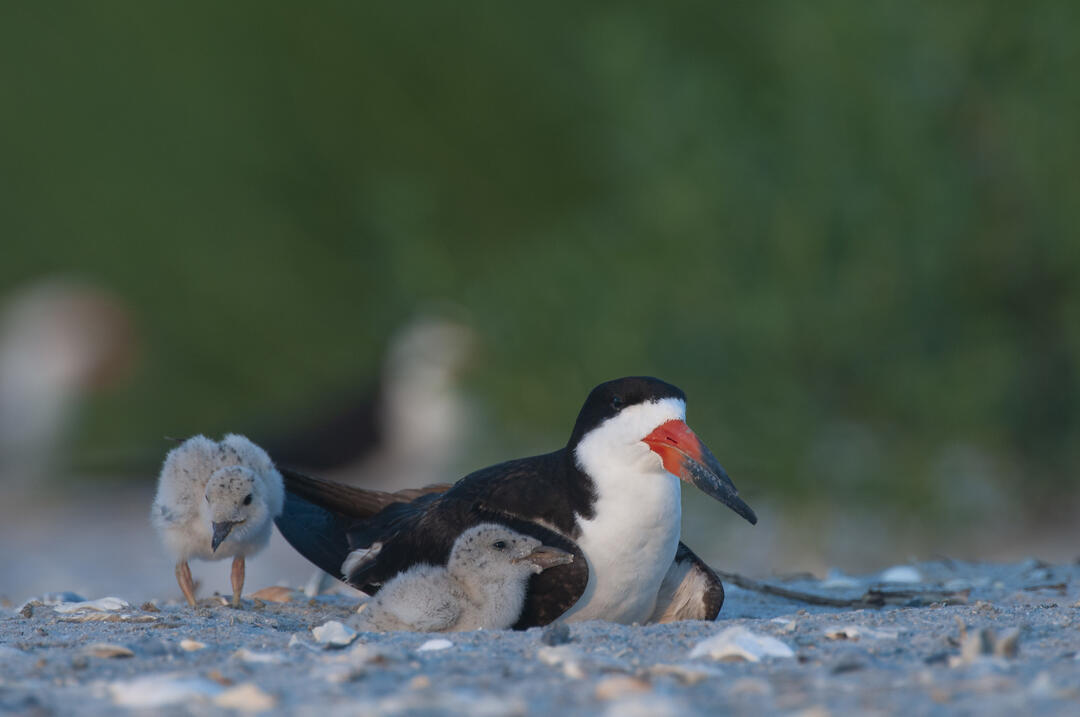Hurricane Debby began to impact the Gulf Coast of Florida on Sunday, August 4, dumping rain along the west coast before making landfall in the Big Bend region as a Category 1 storm on Monday. After spending the season protecting these nesting colonies from disturbance, Audubon Florida’s coastal team along the Gulf and Atlantic Coasts were sad to see widespread losses of nests and chicks when they assessed their sites after the storm. Young shorebird chicks are at risk of drowning during hurricanes, as they cannot yet fly to higher ground.
But it’s not all bad: Coastal birds are adapted to hurricanes and our beach-nesting birds depend on overwash events that create new, open, sandy habitat. When a storm strips a beach of vegetation or covers that vegetation with sand, these newly disturbed areas become the next year's prime nesting sites for plovers, terns, and skimmers. Moreover, storms open inlets and create intertidal habitat that is perfect for shorebirds to forage for food, further boosting their opportunities for a successful nesting season. After 2018’s Hurricane Michael made landfall in the Florida Panhandle, for example, sea and shorebirds hatched more chicks than in previous years.
Suncoast/Tampa Bay
Beaches across Tampa Bay saw storm surges, but shorebird losses in the region were comparatively small. At Clearwater Point the colony’s youngest chick and last egg were lost, but many other beaches had no active nests by the time the storm hit. Good news from St. Pete Beach: The last flightless chick in the colony made it through the storm and was seen huddled under a lifeguard structure on Wednesday morning. Similarly, the flock at Redington Beach was unaffected as they had wrapped their nesting season prior to the storm.
Though Debby did not make landfall there, Sarasota saw record-breaking rainfall and severe flooding. At Lido Key Beach, Shorebird Steward Emily Briner picked up 50 deceased Black Skimmer chicks on Tuesday.
Southwest Florida
Senior Shorebird Project Coordinator Megan Hatten reported the loss of the remaining nests at Second Chance Critical Wildlife Area, a sandbar in Collier County’s Cape Romano, with about 100 Black Skimmer nests and as many pre-fledge chicks washed away. Chicks that had already fledged were able to weather the storm. Hatten counted 50 fledged chicks and 500 adults remaining after the storm, which is close to pre-storm numbers.
Just south of Marco Island, Dickman’s Island was completely inundated by the storm surge, but luckily the Wilson’s Plovers there as well as at Keewaydin Island and Morgan Beach were spared, as they had wrapped their nesting season at the end of July.
In Lee County, the town of Fort Myers Beach experienced severe flooding and our colony at this site was not spared. At Carlos Pointe, Hatten estimated that the 50 remaining Least Tern and Black Skimmer nests with eggs, and 60 small downy chicks were lost when this site flooded. Recently-fledged juveniles were able to move to higher ground to survive the storm surge and were resting on the beach with adult birds.
North Florida: Panhandle and First Coast
Assessments are still underway in both Northeast Florida and the Panhandle. Since most chicks in these regions had fledged before the storm and the most severe impacts were along the Gulf and Big Bend regions, the team anticipates that the birds fared well here.
As climate change brings more catastrophic storms to our shores, the birds are showing that they are adapted to periodic hurricanes and will take advantage of shifting sands and newly available habitat. Audubon’s coastal team will continue to work with local partners to monitor Florida’s beaches, dunes, and barrier islands ahead of the next breeding and nesting season. Like the sea and shorebirds, visitors and residents alike must learn to adapt to stormier seasons as climate change continues to ratchet up the threat of storm surge, flooding, and more.
Hurricane Debby underscores the importance of protecting birds from disturbance early in the nesting season. The earlier the chicks are hatched and fledged, the more likely they will survive summer storms. We must work together with visitors and locals alike to share the shore all summer long.








